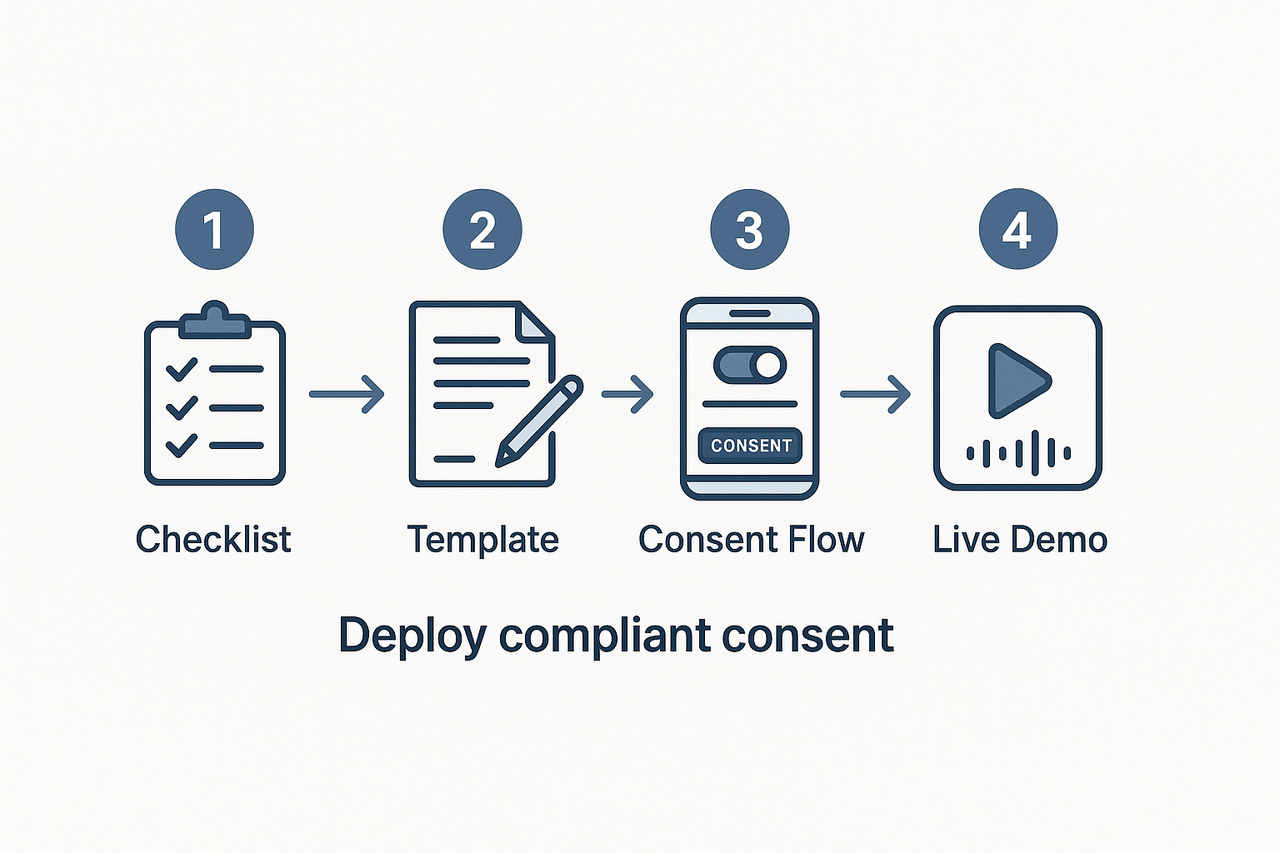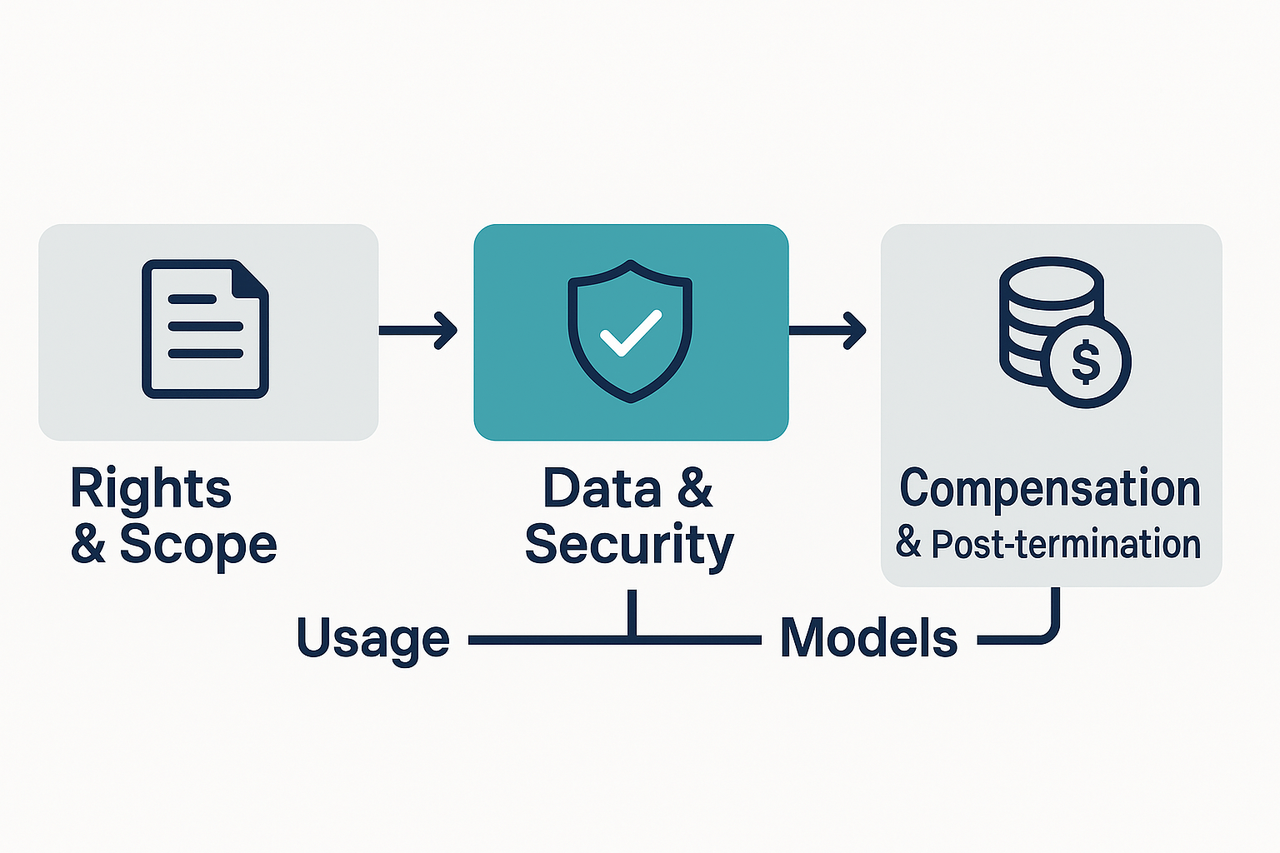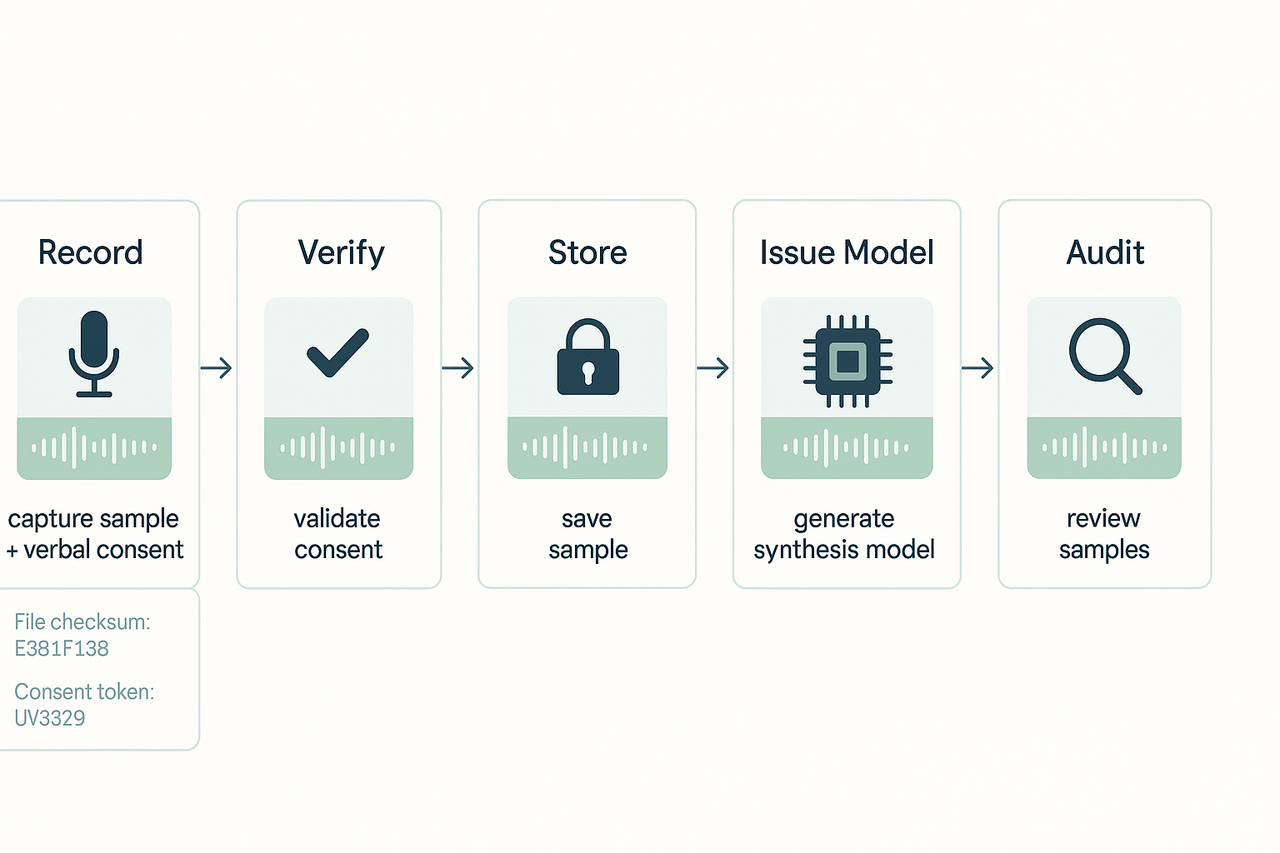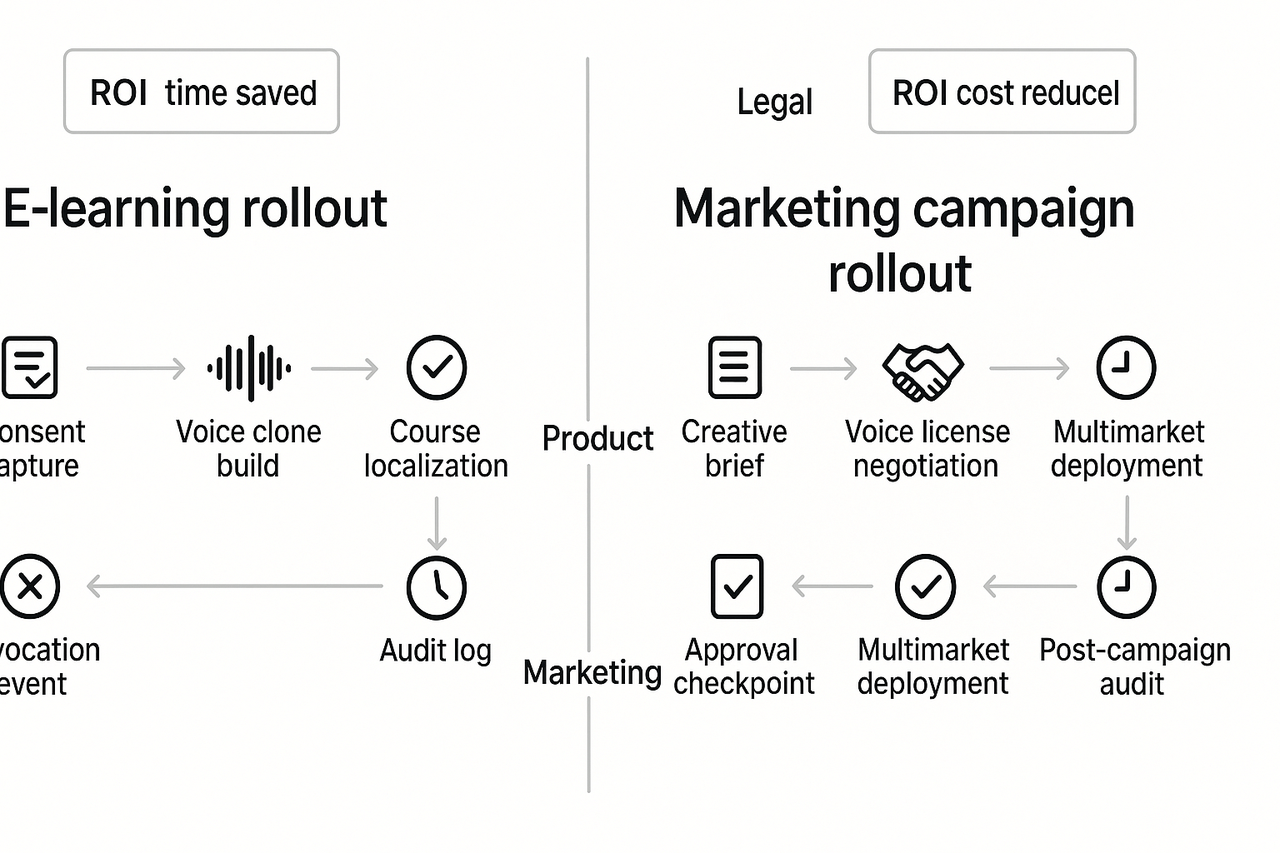TL;DR: What this guide delivers
This guide delivers an annotated, fillable voice cloning agreement, a practical rollout checklist, and demo assets you can use to test consent flows. It lays out the minimum legal and operational steps a business needs to collect compliant consent and deploy professional voice cloning safely.
The annotated template is ready to edit and includes clause notes, negotiation tips, and fallback language for third parties. The checklist assigns roles, maps data flows, sets retention limits, and defines audit gates. Demo assets include short audio samples, consent UI mockups, and a runnable sandbox consent flow.
Use this pack to reduce legal risk, speed deployments, and give creators and voice artists clear rights and payment terms. Plug the template into your contracts, follow the checklist, run the demo, and you can have a working consent process in weeks, not months.
A clear voice cloning agreement matters now because laws, platforms, and audiences all expect explicit consent and risk controls. Businesses that skip a formal contract invite regulatory action, platform removal, and reputational damage. This section explains the legal and public pressure pushing companies to formalize voice use rules now.
Regulatory pressure is rising
Regulators treat synthetic voice as personal data when it can identify a person. The
General Data Protection Regulation (GDPR) has been applied since 25 May 2018. Since then, authorities and lawmakers have stepped up guidance on biometric and voice data. Expect stricter notice, lawful basis (consent or contract), and retention limits in many jurisdictions.
Platforms, contracts, and audience trust
Platforms and marketplaces now require transparency for synthetic media. Voice artists and users expect clear rights, usage limits, and safety guarantees. A short list of what agreements should cover:
-
Clear consent scope, duration, and revocation terms.
-
Permitted channels, languages, and derivative works.
-
Security, storage, and deletion obligations.
-
Liability, indemnity, and reputation controls.
Putting these elements in writing prevents misunderstandings and platform escalations. It also simplifies audits and incident response.
In short, a voice cloning agreement is not just legal padding; it is a business safeguard. It protects the company, the talent, and the audience. Drafting one now reduces regulatory risk and helps preserve brand trust as synthetic voice use scales.
Core clauses every voice cloning agreement must include
A clear, enforceable voice cloning agreement keeps projects legal, ethical, and usable. This section lists the key clauses you need, explains each in plain English, and gives a tightened sample clause you can adapt. Use these to draft enforceable contracts that cover rights, consent, IP, data security, payment, and shutdown rules.
Key clauses at a glance:
-
Rights and scope
-
Consent capture and verification
-
IP ownership and model use
-
Compensation and royalties
-
Data handling and security
-
Verification, approvals, and usage controls
-
Termination and post-termination obligations
Rights and scope: who can use the voice and how
Plain English: Define exactly what the cloned voice can be used for. List permitted media, languages, territories, and duration. Limit or allow sublicensing, transfers, or model retraining.
Sample clause: "Licensor grants a nonexclusive, worldwide, perpetual license to use the licensed voice for the Permitted Uses set out in Exhibit A. Any use outside those uses requires prior written consent."
Consent capture and verification: prove the speaker agreed
Plain English: Say how consent is collected and what it must include. Require a recorded opt-in, ID checks if needed, and a timestamped consent record. Explain revocation rights and effects.
Sample clause: "Provider will obtain and retain written or recorded consent from the Speaker, including a time stamp and proof of identity. Consent may be revoked per Section X; revocation affects only future synthesis."
IP ownership of models: who owns the clone and derivative works
Plain English: State who owns raw recordings, trained models, and derivative outputs. Decide whether the speaker keeps rights or assigns them. Include rights for improvements and model retraining.
Sample clause: "Speaker retains copyright in original recordings. Provider owns models trained solely by Provider, subject to the Speaker license to use outputs for the Permitted Uses."
Compensation and royalties: pay structure and scope
Plain English: Specify fees, one-time payments, recurring royalties, and triggers for extra payments. Cover revenue share for commercial use and leftover credits at termination.
Sample clause: "Client will pay the Fee schedule in Exhibit B. Royalty rates for monetized uses are X% of net revenue. Late payments accrue interest at Y% per month."
Data handling and security: protect voice data and models
Plain English: Require encryption, access controls, retention limits, and deletion procedures. Include breach notification timelines and audit rights.
Sample clause: "All voice data will be encrypted in transit and at rest. Provider will delete raw recordings within 90 days unless otherwise agreed. Security incidents will be reported within 72 hours."
Verification, approvals, and usage controls
Plain English: Build an approval workflow. Allow the speaker to review samples. Add watermarking or metadata tags for provenance if required.
Sample clause: "Client must submit a usage sample for Speaker approval within 5 business days. Approved uses will be logged in the Audit Trail."
Termination and post-termination: wind-down and reuse rules
Plain English: Explain what happens on termination, like revoking licenses and deleting models. Address surviving rights, outstanding payments, and permitted archival use.
Sample clause: "On termination, Provider will cease new synthesis and delete all models derived from Speaker data within 30 days. Surviving rights are limited to existing licensed outputs allowed under Exhibit A."
For more clause templates and an annotated full agreement you can copy and adapt, see our downloadable contract bundle.
Key risks and how to mitigate them
A voice cloning agreement must do more than grant rights. It needs to map technical, privacy, and reputational risks to quick, operational controls you can implement. This section lists the main hazards and gives action-first controls for compliance officers, product managers, and contract teams.
Technical misuse: prevent unauthorized cloning
Model access and stolen audio can let bad actors create fake speech. Lock access and log every clone creation and use. Pair that with short retention windows for raw training files.
-
Enforce API keys and per-user auth. Rotate keys regularly.
-
Require signed, time-limited voice use tokens for exports.
-
Log provenance metadata: who created the clone, source files, and timestamps.
Privacy and data security: limit exposure
Personal voice data is sensitive personal data. Treat it like biometric data and minimize copies.
-
Store raw recordings encrypted at rest and in transit.
-
Use retention policies: auto-delete source files after clone verification.
-
Limit access by role and audit access weekly.
Consent and IP: clear authorizations
Ambiguous consent invites disputes. Define who owns the clone, permitted uses, and revocation steps.
-
Require written, auditable consent forms tied to the agreement.
-
Specify permitted media, territories, and duration.
-
Add a revocation clause and a process for takedown and credential rotation.
Reputation and misuse: guard brand trust
Cloned voices can be used in scams or misleading ads. Protect talent and brand reputations proactively.
-
Approve scripts and final assets before public release.
-
Watermark or tag the synthetic audio where practical.
-
Maintain a rapid response plan for misuse claims.
Regulatory and cross-border risks: stay compliant
Laws differ by country and evolve fast. Build flexibility into contracts and workflows.
-
Include governing law, dispute clauses, and data-transfer safeguards.
-
Map jurisdictional restrictions for biometric rules and export controls.
-
Schedule periodic compliance reviews and update clauses as needed.
Implement these controls in your voice cloning agreement and operational playbook to reduce risk quickly.
Customizing consent frameworks by industry (templates & examples)
A one-size-fits-all contract rarely works for synthetic voice projects. This section gives short, industry-specific consent frameworks and ready-to-use clause language to speed legal review. It also flags which contract elements change by use case, so you can adapt a voice cloning agreement quickly.
What changes by use case
Different uses need different guardrails. Focus on four levers: scope of use (channels, languages, duration), retention and deletion of raw voice data, permitted edits or derivatives, and monetization rights. List those four items in the contract so reviewers can toggle them by project.
-
Scope of use
-
Data retention and deletion
-
Editing and derivative works
-
Payment and revenue share
Media and streaming: short clause
For creators and publishers, emphasize distribution limits and takedown rights. Sample clause:
"Licensor grants a non-exclusive right to clone the Licensor voice for use in audio and video content on digital platforms worldwide for a period of two years. All cloned outputs must include an attribution statement when used in promotional material. Raw voice samples will be deleted within 90 days of project completion unless otherwise agreed."
E-learning and training: short clause
E-learning needs extended use and version control. Sample clause:
"Licensee may use the cloned voice in perpetual, internal training materials. Licensee will maintain version logs of each synth output and seek renewed consent for any public release. Speaker data is stored encrypted and deleted on written request within 30 days."
Call centers and IVR: short clause
Call centers require live use limits and safety checks. Sample clause:
"Cloned voice may be used for automated agent responses for customer service only. Use for sales or outbound calls requires prior written consent. Licensee will implement fraud detection and allow opt-out at the start of each call."
Advertising: short clause
Ads demand express publicity and endorsement terms. Sample clause:
"Use of cloned voice in paid advertising requires express, written publicity consent and a fee per campaign. The artist retains moral rights over endorsements and may veto uses that imply endorsement of political causes."
Each short clause can be dropped into your master template and adjusted for jurisdiction, duration, and security controls. Keep the core consent elements separate, so negotiators can swap permitted uses without reopening the whole agreement.
Cross-border & international considerations
A strong voice cloning agreement must map legal differences before you clone any voice. Start by naming the laws that govern consent, data transfers, and enforcement. That keeps obligations clear for speakers, vendors, and platform teams.
EU and UK: require explicit consent and clear transfers
The EU General Data Protection Regulation (GDPR) (General Data Protection Regulation) demands a lawful basis for processing. Include explicit, documented consent when cloning a voice for marketing or public use. Add data transfer controls like adequacy, standard contractual clauses, or binding corporate rules.
U.S. states: evolving rights and notice rules
Federal privacy rules are limited, so state laws matter most. For example,
Colorado Privacy Act (CPA) went into effect on July 1, 2023, applying to entities that meet specific processing thresholds. Draft consent language to reflect opt-out rights, consumer access, and deletion where state rules require it.
APAC: localize consent and watch residency rules
Asia Pacific laws vary widely, from strict residency rules to lighter notice regimes. Translate consent forms and record informed consent in local languages. Be ready to add data localization clauses or carve-outs for law enforcement demands.
Practical clause checklist
-
Choice of law and venue, and alternative dispute resolution options
-
Defined controller and processor roles, and a Data Processing Addendum
-
Explicit consent text templates by region and language requirements
-
Data export mechanics, encryption, and retention limits
-
Audit and breach notification timelines
End with clear enforcement terms, an express clause on injunctive relief, and a cross-border data transfer exhibit you can update as laws change.
Implementing, enforcing, and auditing the agreement (practical rollout)
Rolling out a voice cloning agreement starts with repeatable, team-friendly steps. This section gives an operational checklist you can apply today to capture consent, protect recordings, and prove compliance for each cloned voice. Follow the workflow and sample scripts here to turn legal language into clear actions for product, marketing, and legal teams.
Prepare the rollout: roles, inventory, and timeline
Assign clear owners. Legal signs templates, product builds capture flows, security handles storage, and compliance audits results. Create an inventory of use cases, speakers, channels, and retention windows. Map each use case to a contract variant so teams know which consent form to use.
Capture consent reliably
Use a short script that explains purpose, limits, and rights. Record verbal consent when you record voice samples and back it with a written checkbox consent for distribution and cloning. Keep these fields: speaker name, date, intended uses, allowed languages, revocation method, and signature or recorded audio hash. Store a copy with the audio file and a human readable summary for ops.
Secure recording and storage
Adopt secure recording practices: use encrypted uploads, ephemeral local storage, and authenticated sessions. Label each file with a version token and a checksum. Limit access to a small group of engineers and compliance officers, and log all downloads and model exports. Consider vendor features that lock cloned voices to the original speaker and prevent reuse without re-consent.
Enforce, monitor, and measure
Enforce rules through policies and automation. Set rule gates in CI or release flows that block publishing of cloned audio without a valid consent token. Track these key metrics:
-
Consent capture rate: percent of voice recordings with valid consent.
-
Time to issue model: hours from consent to deployable clone.
-
Unauthorized use incidents: zero tolerance incidents and time to remediate.
Use dashboards to show trends and alert on drops in capture rate.
Audit, version control, and retention
Keep an immutable audit trail for every clone request, model build, and export. Use version control for agreement templates and for model artifacts. Retain consent proof for at least the contracted retention period, and record revocations as immediate flags that disable models or prevent further exports.
Train teams and define SLAs
Run short role-based training that shows how to capture consent, store files, and trigger audits. Publish SLAs for consent verification, model issuance, and incident response. Practice with a quarterly audit drill to prove the system works.
Checklist: 1) assign owners; 2) standard consent script; 3) encrypted storage; 4) automated gates; 5) audit logs; 6) training and SLA.
Case studies, sample annotated agreement & negotiation tips
This section gives two short case studies that show rollout choices, enforcement decisions, and measurable ROI. It also includes annotated sample clauses you can copy and fill in, plus negotiation red flags counsel should watch. Use the examples to speed a compliant voice cloning agreement and avoid common traps.
E-learning provider: fast localization with strict consent
An online training company cloned five instructor voices to localize courses. They required written consent and a time-bound license for each voice. The rollout cut localization time by weeks and lowered vendor costs by 60 percent while keeping brand voice consistent.
What they enforced: a strict allowed-uses list and revocation terms. They logged consent and stored signed files in a secure audit trail. When an instructor left, the team revoked a clone and used the revocation window to update course assets. That mix of tech controls and contractual limits kept disputes rare.
Marketing agency: campaign speed, brand safety, and reuse limits
A creative agency used two brand voice clones for paid campaigns. They negotiated a limited commercial license, editorial approval rights, and clear reuse fees. The agency shipped campaigns faster and ran A/B tests across markets.
What they enforced: approval checkpoints and an approval metadata tag on all generated audio files. When a brand partner raised misuse concerns, the agency could trace the file and show approval logs. ROI signals were faster campaign cycles and fewer revision rounds.
Sample annotated clauses with fill-in prompts
-
Grant of Rights: narrow license, nontransferable (Fill in: permitted uses, duration, territories). Annotation: list explicit commercial and noncommercial uses.
-
Voice Data and Security: storage, encryption, deletion schedule (Fill in: retention days, deletion process). Annotation: tie deletion to contract termination.
-
Revocation and Take-Down: steps, notice period, remediation fees (Fill in: notice days, remediation fee cap). Annotation: require certificate of destruction.
-
Attribution and Moral Rights: speaker credit and misuse remedies (Fill in: credit format, penalties). Annotation: keep artist moral rights protections clear.
Negotiation red flags for counsel
-
Open-ended licenses. Insist on specific uses and time limits.
-
Broad sublicensing. Avoid clauses that let purchasers resell clones.
-
Vague security promises. Demand measurable security standards and audits.
-
No revocation path. Always build a clear, executable take-down right.
-
Uncapped liability for creators. Cap damages or require insurance.
Finally, keep an editable master template and record every approval. That makes enforcement fast and audits simple.
Vendor comparison and how DupDub fits (product demos & embeds)
When you pick a vendor, match product features to clauses in your voice cloning agreement. Focus on access controls, data handling, and rights to the synthetic voice. This section helps you map contract needs to vendor capabilities so your rollout stays compliant.
Map contract needs to include product features
Start by listing the contract must-haves: identity verification, usage limits, deletion, and audit logging. Check vendor claims against data handling rules. Remember, some standards prohibit storing sensitive authentication data after authorization, as noted by
PCI DSS 3.2 compliance requirements. That rule matters when vendors offer long-term storage or queryable archives.
Quick feature map: what to compare
-
Identity and voice lock: Can the vendor lock a clone to the original speaker session? This supports nonrepudiation.
-
Encryption and processing: Is audio encrypted in transit and at rest? Does the vendor limit sharing?
-
Consent capture and revocation: Can the platform bind recorded consent to a clone and remove a voice on request?
-
API, audit logs, and export: Do logs show who created or used a clone? Can you export evidence for audits?
Why DupDub matters: DupDub offers voice lock-to-speaker, encrypted processing, short-sample cloning, and API access for audit trails. You can preview demos and short audio samples to validate quality and consent flows. For pricing, start with the free 3-day trial, then choose Personal, Professional, or Ultimate plans based on scale.
FAQ — Common questions about voice cloning agreements and consent frameworks
-
What is a reasonable consent duration for voice cloning contracts?
In a voice cloning agreement, pick a clear term: common ranges are 12 to 36 months for commercial use. If you need perpetual rights, say so and offer higher pay. Next step: choose a term, set renewal triggers, and download the fillable template to add the clause.
-
Can I sell or sublicense voice clones: resale rights in voice clone licensing agreements?
Don’t assume resale is allowed. Grant it explicitly if you want it, and limit geography, channels, and sub-licensees. Next step: add a narrow resale clause or deny resale, then request a legal review if you plan wide redistribution.
-
How does revocation work in a voice cloning consent framework?
Allowing revocation is common, but make effects clear: typically it stops future uses, not past distribution. Define notice method, deadlines, and remediation. Next step: add a revocation process to the template and test the workflow.
-
Do I need a translation license for dubbing and multilingual use?
Yes, multilingual dubbing often needs separate rights for translated scripts and localized performance. List allowed languages, territories, and media in the contract. Next step: specify languages and fees in the template or ask legal to draft a translation rider.





